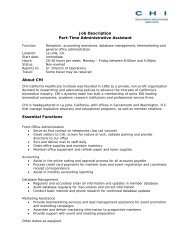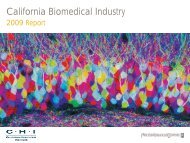California Biomedical Industry - California Healthcare Institute
California Biomedical Industry - California Healthcare Institute
California Biomedical Industry - California Healthcare Institute
Create successful ePaper yourself
Turn your PDF publications into a flip-book with our unique Google optimized e-Paper software.
Researcher profileClodagh O’Shea, Ph.D., is an assistantprofessor in the Molecular Celland Biology Laboratory at the Salk<strong>Institute</strong> and a recipient of The SontagFoundation’s 2009 DistinguishedScientist Award, which includes a grantof $600,000 over four years to developnew viral therapies to treat brain tumors.O’Shea is an expert on oncolytic viruses.Explain how your lab isdeveloping viruses that targetspecific tissues in the body.The virus is an incredible nanomachine that can be re-engineered onseveral levels for cancer. One way is tomanipulate how the virus binds to a cell.If you can imagine the virus as a rocketship with spikes, it uses these points tomake contact with the cell’s surface andthereby enters specific cells. The virusthat has been used in research naturallyenters the cells in our airways. But thereare 52 human adenoviruses and eachtargets different tissues. If you are goingto treat cancer in the colon, we believeyou should use a virus that has evolvedto target that tissue. And now that iswhat we are doing for the first time, andwhich no one has been able to do.How did you become interested inthis area of research?I earned my doctorate in immunologyin London’s Imperial Cancer Research<strong>Institute</strong> and was pursuing a career intumor immunology. But as a student Iheard (UCSF cancer researcher) FrankMcCormick, who I did my postdoc with,come through and give a talk on thisidea of making a mutant virus that canactivate p53 and then kill tumor cells.(Called the “Guardian of the Genome,”the p53 gene is almost always foundto be inactive in all human cancers.)The idea that you depend on the loss ofthe p53 gene just fascinated me. Howdo you activate something that is justgone? I just thought, “I’ve got to workon this.”What has been the scientificdiscovery that has fascinatedyou the most during your career?The cell is a scale-free network, whichis like the World Wide Web. By thatI mean that not all nodes or points ofcontact in a network have the samenumber of connections. Some nodes, forexample, are hubs, they have thousandsof connections, but many others haveonly a few. This explains many things.Think about a tumor. There have nowbeen 100,000 mutations identified incancer. Many of them are probablyirrelevant. You can lose about 5 percentof the genes in your cell and your cellwill be fine. And that is because they arenot connected to major processes. Butsome of these genes are hubs, which iswhy they have profound effects in somany pathways.That for me explained why the genetictargets the virus is hitting and why theones the tumor is hitting are the same.Even though there are 26,000 genesin a cell, the virus has just 20, so that’sprobably the number you need to hitto control the cell. If you can controlthe hub you can control many differentprocesses. The same holds true forcancer. You can take all these mutationsand still survive. But if you hit just thecritical target, that’s it. And that’s whatwe need to understand in cancer. Weneed to understand those (genetic) hubsand how those connections have beenperturbed.What fuels your passionfor science?Science is knowledge, and knowledgeimproves the human condition in itspurest sense. It is not so much aboutbeing published in scientific journals.For me, it is about that one momentwhen you know you are the only personwho has ever discovered this one thing— it’s extraordinary. It is a celebrationof life at its deepest level. To understandeven a fraction of how it can be andthen to share it with others is really justamazing.It can never be negative because you canonly add to knowledge, and for me thatis a very powerful thing. Also knowingthat I can actually help someone beyondme by wielding that knowledge toalleviate suffering through therapieskeeps me passionate about science. Andfinally, just seeing that joy of knowledgein my postdocs is also extraordinary.On working at The Salk <strong>Institute</strong>:I had not focused on brain cancer untilI came to the Salk and breaking intothe field would have been very difficultwithout their support. I am extremelyexcited to be able to translate thegenetic understanding of brain cancerinto transformative treatments forpatients suffering from this terribledisease. To achieve this, we willcombine new viral vectors, tools andmouse models in a way that has neverbeen done before. It is high risk but itreally could change things.86 | <strong>California</strong> <strong>Biomedical</strong> <strong>Industry</strong> 2011 Report






